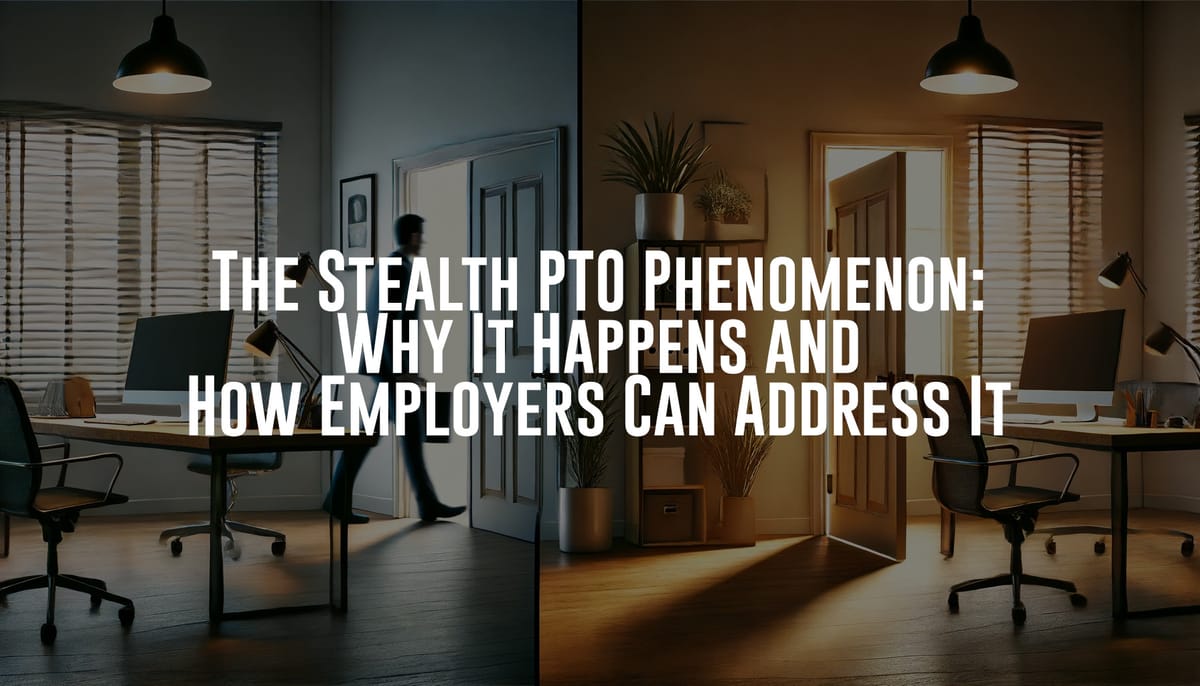The Stealth PTO Phenomenon: Why It Happens and How Employers Can Address It
Explore why employees resort to Stealth PTO and discover how employers can foster a culture that encourages open communication and healthy work-life balance to prevent this practice.

Introduction
The term "Stealth PTO" refers to the practice of employees taking paid time off without officially logging it or informing their employers. This trend, while often a symptom of deeper workplace issues, can be mitigated with the right cultural and managerial approaches. This article delves into why employees feel compelled to take Stealth PTO and how employers can address these underlying issues to foster a healthier, more transparent work environment.
Why Employees Resort to Stealth PTO
Understanding the motivations behind Stealth PTO is crucial for employers aiming to cultivate a more supportive and communicative workplace. Here are some common reasons why employees might engage in this practice:
Fear of Judgment or Repercussions
Many employees fear that requesting time off will be perceived negatively by their managers or peers, potentially impacting their career advancement.
- Perceived Weakness: Taking time off might be seen as a sign of weakness or lack of dedication.
- Job Security: Employees may worry about job security if they take too much time off.
Overwhelming Workload
High workloads and tight deadlines can make employees feel that they cannot afford to take time off, even when they need it.
- Pressure to Perform: The constant pressure to meet targets can deter employees from requesting time off.
- Lack of Backup: Employees may feel there is no one to cover their duties in their absence.
Lack of Supportive Work Culture
A workplace culture that does not actively encourage or support taking time off can lead employees to resort to Stealth PTO.
- Unsupportive Management: Managers who do not model or support time off can contribute to a culture where employees feel they cannot take breaks.
- Poor Communication: A lack of open communication about the importance of rest and work-life balance can reinforce the need for Stealth PTO.
How Employers Can Prevent Stealth PTO
Addressing the root causes of Stealth PTO requires a multi-faceted approach that includes fostering a supportive culture, improving communication, and demonstrating genuine concern for employee well-being.
Foster a Culture of Trust and Transparency
Building a culture where employees feel safe to take time off starts with trust and transparency.
- Open Communication: Encourage open dialogue about the importance of taking time off and make it clear that employees will not be judged for needing rest.
- Lead by Example: Managers should model healthy behavior by taking their own time off and being transparent about it.
- Clear Policies: Ensure that the company’s PTO policies are clear, fair, and easily accessible to all employees.
Address Workload and Resource Issues
High workloads and a lack of backup are significant barriers to employees taking time off. Employers can address these issues by:
- Resource Planning: Implement better resource planning to ensure that workloads are manageable and that there is sufficient coverage when someone is on leave.
- Flexible Work Arrangements: Offer flexible work arrangements, such as remote work or flexible hours, to help employees manage their time more effectively.
Promote Work-Life Balance
Promoting a healthy work-life balance can prevent the need for Stealth PTO.
- Regular Breaks: Encourage regular breaks throughout the day and discourage a culture of constant availability.
- Mental Health Support: Provide access to mental health resources and support, such as counseling services or stress management workshops.
- Work-Life Integration: Foster an environment where work-life integration is valued and supported, rather than expecting employees to be always on.
Recognize and Reward Healthy Behaviors
Recognizing and rewarding employees for maintaining a healthy work-life balance can reinforce positive behaviors.
- Acknowledgment: Publicly acknowledge employees who take time off and return refreshed and productive.
- Incentives: Offer incentives for employees to use their PTO, such as additional time off or wellness-related rewards.
Implement Feedback Mechanisms
Regularly seeking feedback from employees can help identify issues early and adjust policies accordingly.
- Surveys and Check-Ins: Use surveys and regular check-ins to understand how employees feel about their workload and ability to take time off.
- Anonymous Feedback: Provide anonymous channels for employees to voice their concerns without fear of retribution.
Real-Life Examples of Addressing Stealth PTO
To illustrate how these strategies can be effective, let’s look at how some companies have successfully mitigated the need for Stealth PTO:
- Tech Industry Leaders: Companies like Google and Microsoft have implemented robust wellness programs and flexible work policies, resulting in high employee satisfaction and reduced need for Stealth PTO.
- Innovative Startups: Smaller firms often lead by example, fostering close-knit cultures where open communication and mutual support are the norms.
Conclusion
Stealth PTO is a symptom of deeper workplace issues that can undermine employee well-being and productivity. By understanding why employees feel compelled to take time off in secret and implementing strategies to address these root causes, employers can create a more supportive, transparent, and healthy work environment. Cultivating a culture of trust, promoting work-life balance, and ensuring manageable workloads are key steps in preventing the need for Stealth PTO and enhancing overall workplace satisfaction and performance.Employers who proactively address these issues not only support their employees' well-being but also enhance their organization's resilience and attractiveness as a great place to work.





